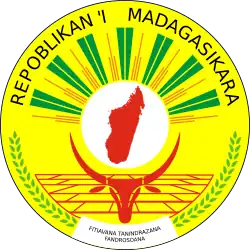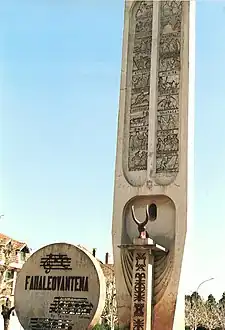Ry Tanindrazanay malala ô!
"Ry Tanindrazanay malala ô!" (Malagasy pronunciation: [ri taniⁿɖ͡ʐazanaj malala o]) is the national anthem of Madagascar. The lyrics were written by Pasteur Rahajason, and the music by Norbert Raharisoa. It is similar to a march and was strongly influenced by European music and the French colonial education system. It is often played by Malagasy musicians on the accordion.[2]
| English: Oh, beloved land of our ancestors! | |
|---|---|
 | |
National anthem of | |
| Lyrics | Pasteur Rahajason, 1958 |
| Music | Norbert Raharisoa, 1958 |
| Adopted | 27 April 1959[1] |
| Audio sample | |
| |
The anthem was officially adopted on 27 April 1959 by the parliament of Madagascar prior to the official granting of independence on 26 June 1960. Philibert Tsiranana was Prime Minister of Madagascar during the creation of the anthem, and Michel Debré was the French Prime Minister during this time. The main focus of the anthem is love of the land, as well as thankfulness to God and an appeal to unity and loyalty under the nation.
History
Pastor Rahajason (1897-1971) is credited with writing the national anthem of Madagascar.[3][4] He was influenced by the French colonial education system, the aim of which was to assimilate the colonised people and was part of the broader civilising mission. This system was designed to orient local Malagasy populations towards the French colonial project, promoting strong ties to the French language, as well as French civilisation, values and cultural preferences. The schools were often associated with various missionary organisations, imparting a strong religious education overtone, also accounting for Rahajason's exposure to Christianity and his subsequent decision to become a pastor.[5]
Norbert Raharisoa (1914-1963) is credited with composing the national anthem of Madagascar. Raharisoa was also a music teacher and professor.[3] He died shortly after the adoption of his composition. He was honoured for his contributions to Malagasy culture by being featured on the 40 franc postage stamp in 1967. Like his colleague Rahajason, Raharisoa was raised under the French colonial education system, which explains the colonial influence on the anthem.[5]
The national anthem was officially adopted on 27 April 1959, approximately one year before Madagascar achieved independence from France, on 26 June 1960.[6] The anthem was originally written in French and Malagasy.[7]
Music
The anthem is written as a European-style march, consistent with many national anthems around the world.[2] The march is traditionally a military style, with a strong and even beat, originally meant to help troops "march" in step while travelling.[8]
The anthem betrays its colonial influence through the general absence of local musical styles and instrument types. Ron Emoff, professor of music and anthropology at OSU Newark, notes that the anthem is not played in the vakondra-zana style, which is the style of the ancestors' music, also known as a form of traditional music.[2] Emoff also notes that the anthem is usually not played on the local instrument, the valiha[2]. This is because the anthem replicates the same essential ingredients that European hymns use, which are themselves based on old religious and nationalistic hymns.[7]
Lyrics
| Malagasy lyrics[9][10] | IPA transcription[lower-alpha 1] | French translation[11] | Literal English translation of the French |
|---|---|---|---|
I |
1 |
I |
I |
Analysis of lyrics

Writing about Madagascar, researcher Igor Cusack explains that its anthem was influenced by its French colonial masters and featured the themes: blessed by God, God save our land/people, and a nonspecific love of their beloved land.[12]
According to Cusack, the first stanza focuses on an all-encompassing love of the nation and the land. It opens with a collective remembrance and affection for the past and the ways of the past as represented by the ancestors and closes with a nationalistic promise of fidelity and loyalty to the nation.[12]
Cusack states that the chorus is a prayer to the Creator, who is most likely the Christian God, based on Madagascar's French colonial legacy. It connects the present once again to the past of the ancestors and asks a general blessing of joy and happiness on the country and its people.[12]
The third stanza, Cusack states, is a response to the beauty of Madagascar and the love of its citizens have for it. They affirm their connection to the nation and their desire to serve the nation with body, heart and soul.[12]
The final stanza is said to reaffirm the love the Malagasy have for their beloved nation and ask blessings on it and its people by again referencing the Christian God.[12]
Notes
- See Help:IPA/Malagasy and Malagasy language § Phonology.
References
- "Madagascar". Nationalanthems. David Kendall. Retrieved 20 September 2012.
- Ron., Emoff (2002). Recollecting from the past : musical practice and spirit possession on the east coast of Madagascar. Middletown, Conn.: Wesleyan University Press. ISBN 9780819565006. OCLC 47922731.
- "Madagascar". nationalanthems.info. 16 February 2013. Retrieved 16 November 2017.
- Harison, Marie Aimé Joël (2005). Musikgeschichte Madagaskars: unter besonderer Berücksichtigung der europäischen Einflüsse (in German). Dr. Kovač. p. 191. ISBN 978-3-8300-1775-2.
- Rosnes, Ellen Vea (2 November 2017). "Christianisation, Frenchification and Malgachisation: mission education during war and rebellion in French colonial Madagascar in the 1940s". History of Education. 46 (6): 749–750. doi:10.1080/0046760x.2017.1368723. ISSN 0046-760X. S2CID 148786962.
- "The World Factbook — Central Intelligence Agency". www.cia.gov. Retrieved 20 November 2017.
- Lengyel, Emil (7 October 1962). "New Nations Sing Out: The creation of national anthems for ex-colonials raises language problems". New York Times.
- "march | music". Encyclopedia Britannica. Retrieved 27 November 2017.
- "Hymne national de Madagascar". Présidence de la République de Madagascar (in French). Retrieved 3 February 2022.
- A Glance at Madagascar. Librairie "Tout Pour L'École". 1973. pp. 97–98.
- "Madagascan national anthem - words and translation - All about Madagascar -". Scotland's National Centre for Languages. Retrieved 3 February 2022.
- Cusack, Igor (2005). "Beat the drums, the red Lion has roared". Journal of African Cultural Studies. 17 (2): 235, 238, 244, 248. doi:10.1080/13696850500448337. S2CID 163149597.
External links
- Madagascar: Ry Tanindrazanay malala ô - Audio of the national anthem of Madagascar, with information and lyrics (archive link)